As much as the pumpkin is used as a term of ridicule, who ever saw a pumpkin that seemed to quail or look sheepish? Henry Ward Beecher
Henry Ward Beecher (1813-1887) was minister of the Plymouth Congregational Church in Brooklyn. He is best known for his break with his father’s hell and brimstone Calvinism to a belief in a God of love and for his anti-slavery stand. During Bloody Kansas he raised funds to send breech-loading, self-priming Sharps rifles to the abolitionist forces there saying they would do more good than 100 Bibles. The press nicknamed the rifles Beecher’s Bibles.
 With this background it is perhaps surprising to learn that he wrote extensively about agriculture and rural life. Writing ran in his family. His sister Harriet Beecher Stowe authored Uncle Tom’s Cabin and Catherine Beecher wrote A Treatise on Domestic Economy by Use by Young Ladies at Home and School among other works on moral education and the role of women.
With this background it is perhaps surprising to learn that he wrote extensively about agriculture and rural life. Writing ran in his family. His sister Harriet Beecher Stowe authored Uncle Tom’s Cabin and Catherine Beecher wrote A Treatise on Domestic Economy by Use by Young Ladies at Home and School among other works on moral education and the role of women.
Beecher’s earliest writing was for the agricultural journal The Farmer and the Gardener. In 1862 he published Eyes and Ears, a collection of articles he had written for the New York Ledger. Beecher characterized these pieces as “careless”, “fragmentary” thoughts “rapidly thrown off” with the purpose of entertainment that might inspire the love of nature and rural life or perhaps alleviate the tedium of sickness. The following excerpt is from “The Pumpkin Family – Its Relatives and Rivals” p. 326-7.
The pumpkin is in the situation of a hero without a poet or historian. Its merits are worthy of renown. But it had found no worthy eulogist. Its vine is a little coarse, compared to the clematis, the honeysuckle, or the convolvulvus. What great hands it holds up to the sun, broad, succulent, rough! And the leaf-stalk, is it not the trumpet, the cheap squirt-gun, the blow-pipe, and I know not what else, of ingenious boyhood? …
But in due time, behold the fruit. Even when green it is delightsome to the eyes.  The unstinted fullness of the great round, plump fellow; then the exquisite veining when the forces of Nature turn green to orange, and a network of green lines among yellow surfaces surpasses in ingenuity and frolicsome beauty anything that Raphael ever formed in arabesque, or that Cellini traced upon his curiously-wrought goblets. Indeed every artistic goldsmith should attentively study the pumpkin. Its foundation colour is quite in his way. Its lines are finer than he can fashion, and its meshes of green and gold, netting the great orb with an entanglement of figures that would have brought a Moorish artist to his knees in admiration…
The unstinted fullness of the great round, plump fellow; then the exquisite veining when the forces of Nature turn green to orange, and a network of green lines among yellow surfaces surpasses in ingenuity and frolicsome beauty anything that Raphael ever formed in arabesque, or that Cellini traced upon his curiously-wrought goblets. Indeed every artistic goldsmith should attentively study the pumpkin. Its foundation colour is quite in his way. Its lines are finer than he can fashion, and its meshes of green and gold, netting the great orb with an entanglement of figures that would have brought a Moorish artist to his knees in admiration…
After such a glowing description, we should be hungry for pumpkin pie. Here is Catherine Beecher’s recipe for pumpkin pie from her 1871 Domestic-Receipt Book.
Take a pumpkin, or winter squash, cut into pieces, take off its rind, and remove the seeds, and boil until tender, and then rub it through a sieve. When cold add milk to it to thin it, and for each quart of milk three well-beaten eggs. Sugar, cinnamon, and ginger to your taste. The quantity of milk must depend upon the size and quality of the squash. These pies require a moderate heat, and must be baked until the centre is firm.


Leave a comment